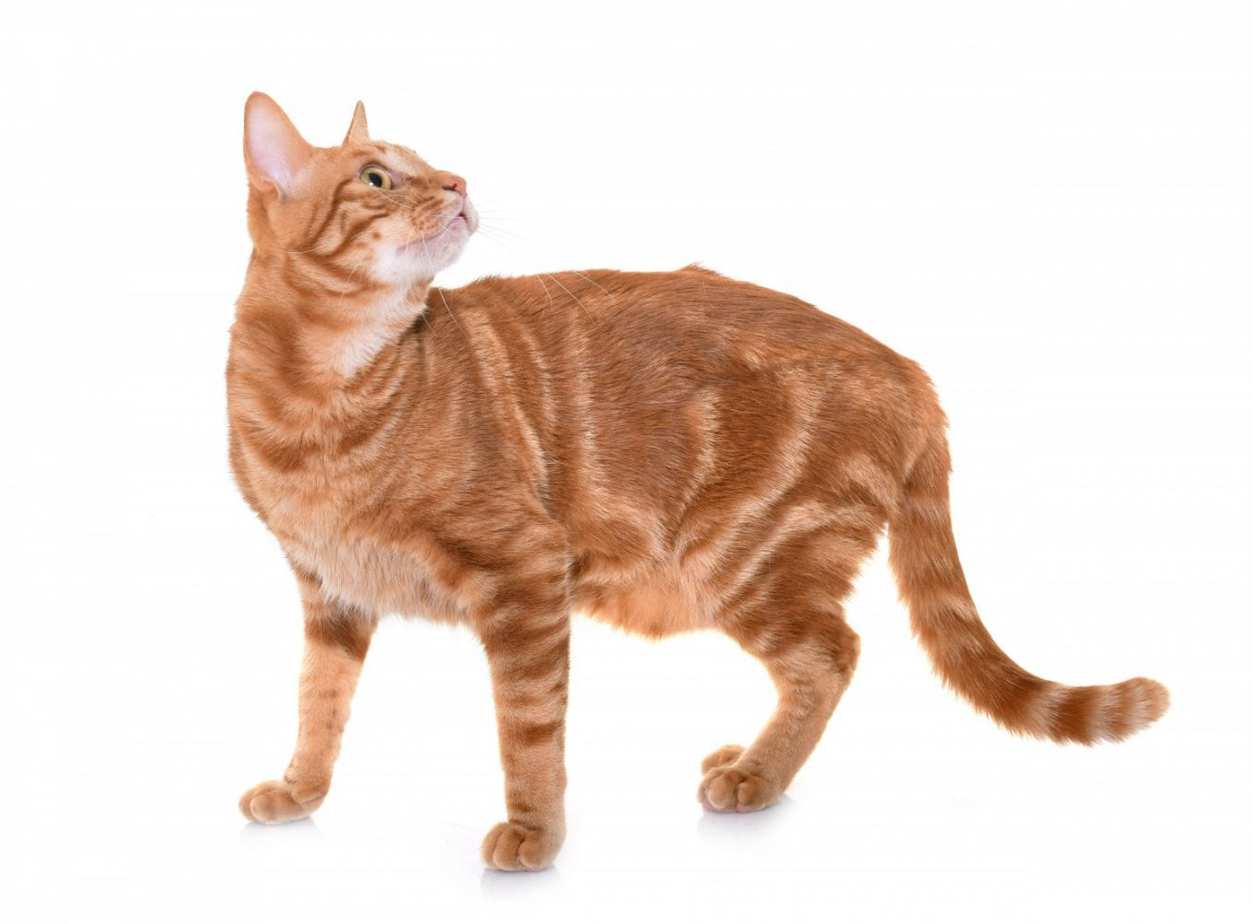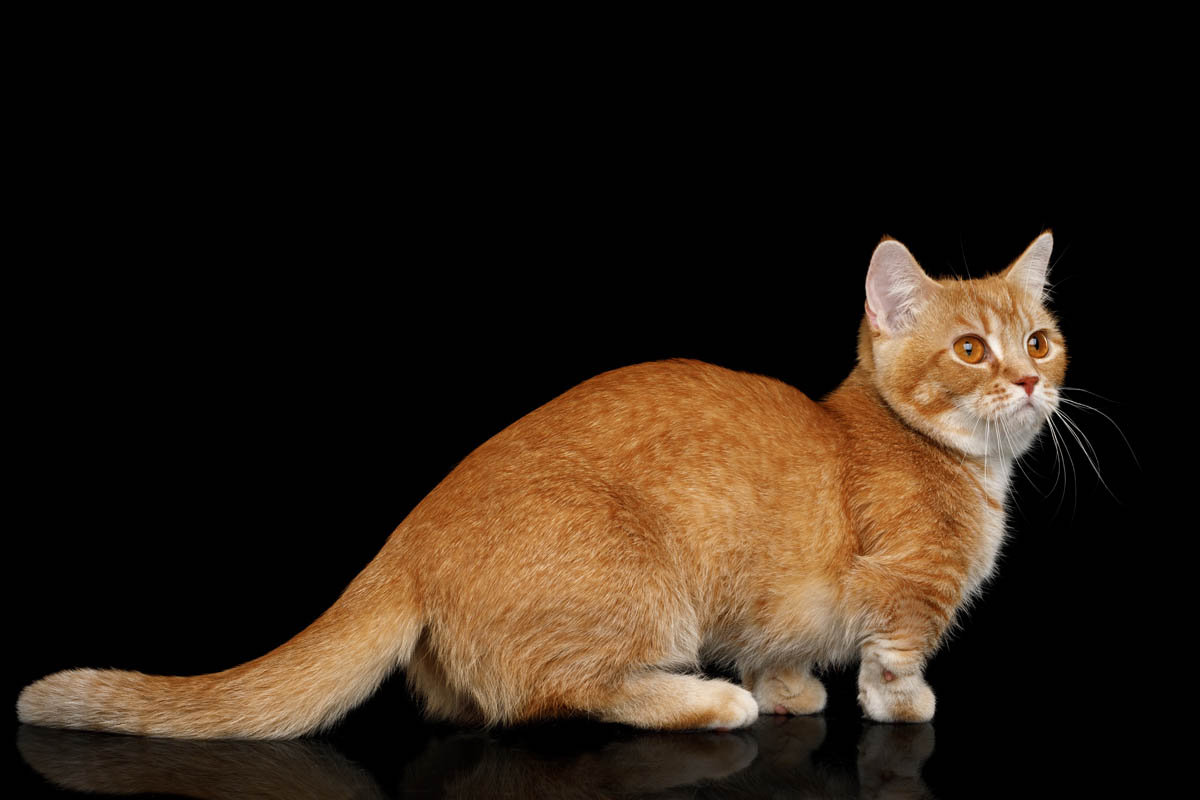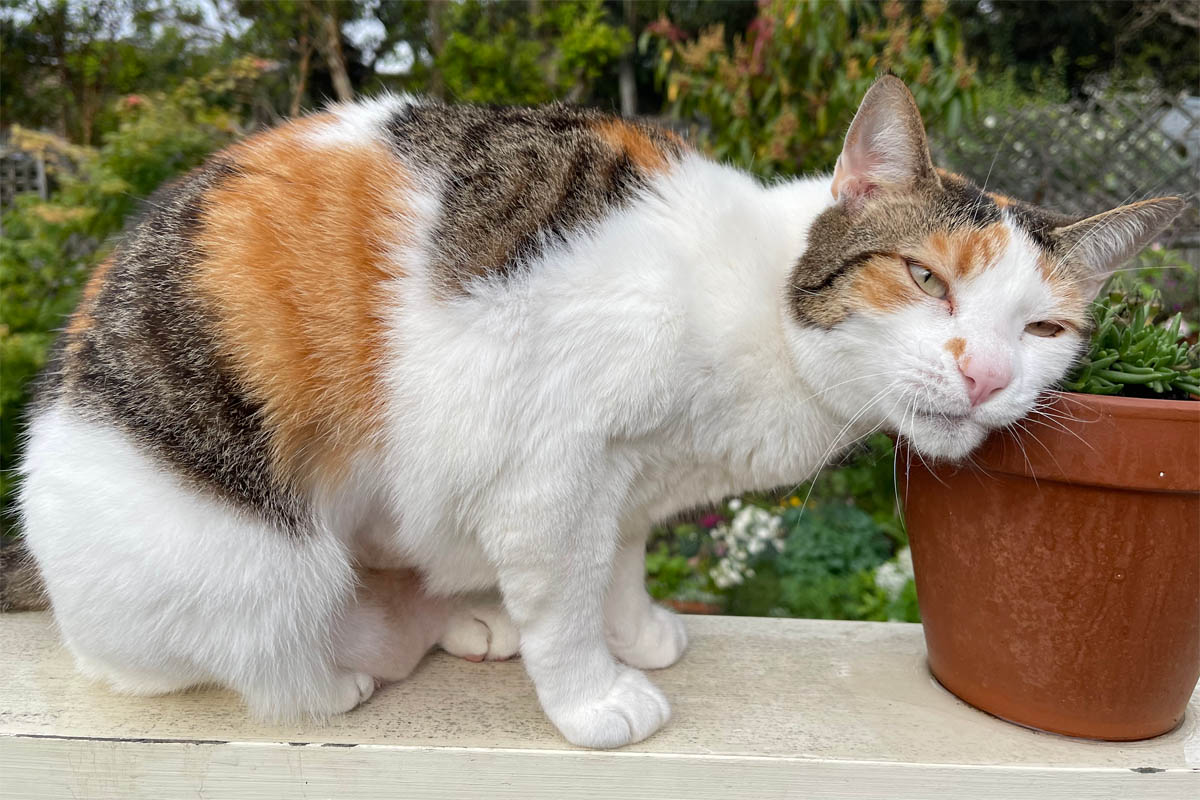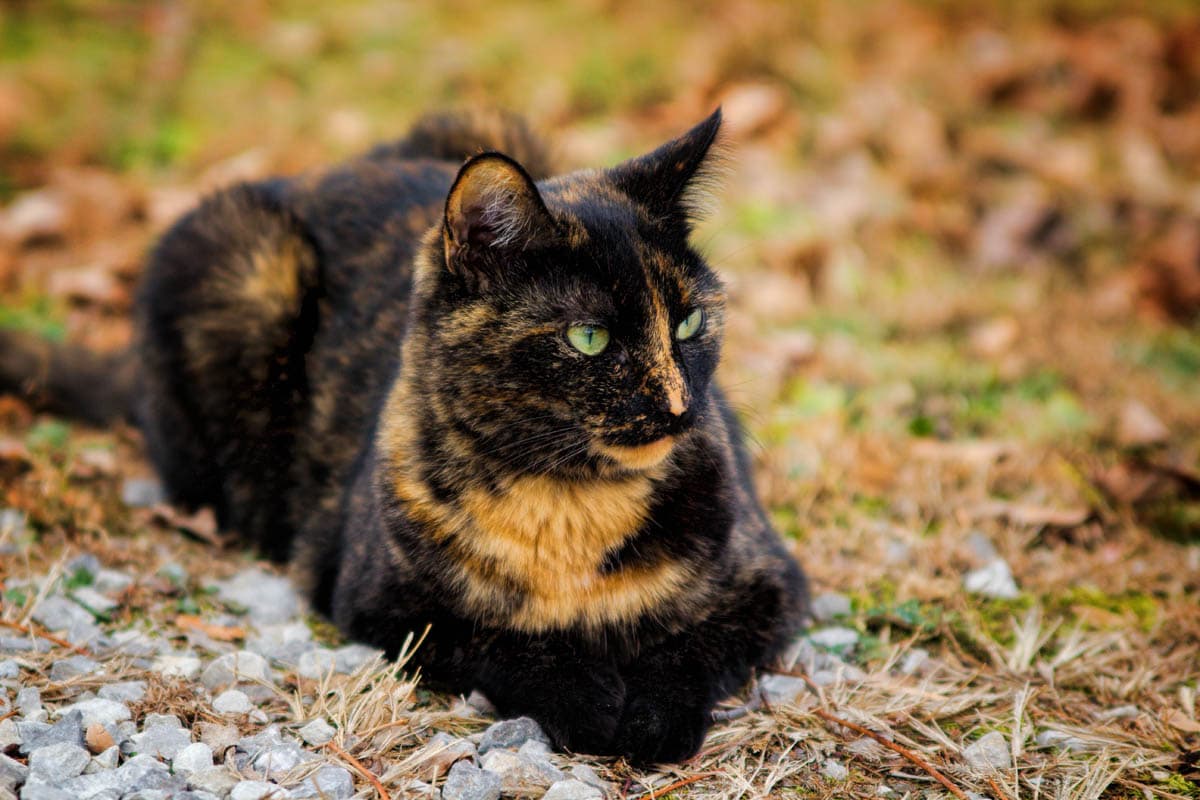Also known as a red tabby, an orange tabby is a common coat colour that consists of a base colour that ranges from a light cream or yellow-orange to a deep, rich red or ginger, which is a backdrop for the darker stripes, spots, or swirls.
Orange tabby is a common coat colour and not a specific breed, it can be found in both random bred as well as some breeds of purebred cat. The tabby coat pattern is made up of two components; the base agouti (ticked) background which is composed of alternating light and dark bands on each hair, and the overlying dark spots, swirls or stripes. The default ‘wild type‘ cat is a brown mackerel tabby.
The pigment responsible for the orange colour is known as pheomelanin, which provides yellow and orange colours while eumelanin is responsible for black, brown and grey coat colour. Pheomelanin contains more sulfur and is composed of benzothiazine units, leading to lighter colouration while eumelanin is composed mainly of dihydroxyindole and dihydroxyindole carboxylic acid, resulting in darker colouration.
Types of tabby pattern
1. Mackerel Tabby (Mc):

The mackerel tabby pattern is the wild-type (original) pattern of the African wildcat (Felis silvestris lybica), the closest wild ancestor of the domestic cat (Felis catus). The vertical striping seen in mackerel tabbies serves as a form of camouflage, allowing wild cats to blend into tall grasses and vegetation effectively, which is crucial for hunting and evading predators.
- Appearance: This pattern is characterised by narrow, parallel vertical stripes running down the cat’s sides, resembling the bones of a fish, hence the name “mackerel.”
- Markings: The mackerel tabby has stripes running down the legs and tail, and dark lines running down each side of the spine.
- Commonly Seen In: Most domestic shorthair and longhair cats.
2. Classic Tabby (mc/mc):

The classic tabby is recessive to the wild-type mackerel tabby. The cat must inherit two copies of the tb gene, one from each parent tb/tb. Two classic tabbies cannot produce offspring with the mackerel tabby pattern, but a mackerel tabby cat can potentially produce offspring with the classic tabby pattern if they carry one copy of the tb gene, ie: Tm/tb
- Appearance: Also known as “blotched” or “marbled,” this pattern features bold, dark, swirling or circular patterns on the sides, resembling a marble pattern.
- Markings: It typically has three large, dark, and bold stripes running down the spine, merging into the swirls and loops on the sides.
- Commonly Seen In: Mixed breeds, British Shorthair, American Shorthair, and Maine Coon breeds.
3. Spotted Tabby:

The spotted pattern is a modification of the mackerel pattern, where the stripes are broken into spots due to a modifier gene. These spots can vary widely in size and distribution across different cats, leading to a diversity of spotted tabby appearances.
- Appearance: As the name suggests, this pattern features spots all over the body, which can vary in size and spacing.
- Markings: Spots can be round, oval, or rosettes, similar to those seen in wild leopards or cheetahs.
- Commonly Seen In: Mixed breeds, Egyptian Mau, Bengal and Ocicat.
4. Ticked Tabby (agouti):

Also known as ‘agouti’, the ticked tabby pattern, doesn’t have the traditional stripes, spots, or swirls that are typically associated with tabby patterns because of the unique way the agouti gene affects the hair shaft’s pigmentation.
- Appearance: This pattern lacks the traditional stripes or spots on the body but has multiple bands of colour on each hair shaft, giving a flecked or speckled appearance.
- Markings: The face, legs, and tail typically feature some degree of striping, but the main body does not have the typical large-scale patterns of the other tabby types.
- Commonly Seen In: Mixed breeds, Abyssinian, Burmilla, Munchkin, Somali, and Singapura breeds.
5. Caliby (patched tabby):

The caliby pattern is almost exclusive to female cats. It is made up of patches of red tabby, along with a second tabby colour (usually brown), along with areas of white. Because female cats have two X chromosomes, they can display two colours, in this case, red and brown tabby. Males only have one X chromosome, so will be red or non-red.
- Appearance: A mixture of tabby colours in patches, usually red and cream, along with a second tabby colour.
- Markings: Caliby is seen primarily in females due to the genetic makeup related to colour genes on the X chromosome.
- Commonly Seen In: Mixed breeds, Devon Rex, Cornish Rex, Sphynx, British Shorthair, Scottish Fold, Oriental Shorthair.
Calico

As with the caliby, the calico pattern occurs in white cats due to the female having two X chromosomes which that she is able to display both orange and non-orange, with the addition of white. The red is tabby, and the second colour, most commonly black, is solid.
- Appearance: A mixture of colours in patches, usually red and cream, along with a second solid colour.
- Markings: Caliby is seen primarily in females due to the genetic makeup related to colour genes on the X chromosome.
- Commonly Seen In: Mixed breeds, Devon Rex, Cornish Rex, Sphynx, British Shorthair, Scottish Fold, Oriental Shorthair.
Tortoiseshell

Another sex-linked pattern that occurs in female cats is the tortoiseshell which has a brindle appearance of orange and black, orange and chocolate or cream and blue, or tortoiseshell and white if she inherits the white spotting gene too. Interestingly, in most cases, the white spotting gene causes the colours to form patches, making it a calico, instead of the characteristic brindle seen in the tortoiseshell cat.
- Appearance: A mixture of colours in random patches, usually red and cream, along with a second solid colour.
- Markings: Caliby is seen primarily in females due to the genetic makeup related to colour genes on the X chromosome.
- Commonly Seen In: Mixed breeds, Devon Rex, Cornish Rex, Sphynx, British Shorthair, Scottish Fold, Oriental Shorthair.
The orange gene is sex-linked
The orange gene, denoted as ‘O,’ is sex-linked, due to its location on the X chromosome. Cats inherit two copies of each gene, one from the mother and one from the father. Male cats (XY) only have one X chromosome, so they are either orange or non-orange. Because the orange gene is dominant, it masks eumelanin, the pigment for black or brown. This means that if a male cat only inherits one copy of the orange gene, he will be orange, regardless of the other colour genes present.
As female cats (XX) have two X chromosomes, they can be homozygous for orange (OO), homozygous for non-orange (oo) or heterozygous (Oo).
- The homozygous (OO) female cat will be ginger
- The homozygous (oo) non-orange cat will be non-orange (black, brown, grey etc.)
- The heterozygous female (Oo) will be tortoiseshell, calico or caliby
The tortoiseshell pattern is made up of patches of orange and black, orange and chocolate, or if the cat also carries the dilution gene, cream and blue (cream is the dilute of orange). If the cat also carries the white spotting gene, she will be tortoiseshell and white, calico or caliby.

All orange cats are tabby
As cats have evolved, genetic mutations have occurred many of which are responsible for the vast array of colours and patterns we know and love. The non-agouti (a/a) or hypermelanistic gene, overlays the agouti base colour with melanin pigment to produce a solid-coloured cat. This gene only affects the distribution of eumelanin (black pigment) but does not impact the distribution of phaeomelanin (red pigment). As a result, all orange cats display the tabby pattern.
White markings
Some orange cats have the addition of white markings, typically located on the belly, legs and throat, caused by the white spotting gene. This mutation is the result of an insertion of feline endogenous retrovirus in the KIT gene. The white spotting gene prevents melanocytes from proliferating fast enough which means the dark-coloured pigment cells are unable to spread as far as they do on other, non-piebald, creatures, in time to pigment the hair and skin, leaving areas of non-pigmented fur, typically the legs and underside of the cat.
Male vs female
As noted, the orange gene is located on the X chromosome, which makes it a sex-linked trait.
- Males (XY) only have one X chromosome, so they will either be orange, or non-orange.
- Females (XX) have two X chromosomes and will be orange if they inherit two copies of the orange gene, or tortoiseshell, calico or caliby if they inherit only one copy.
Because males only need one copy of the orange gene to be ginger, it is more common to find orange males than females. The female must be homozygous (OO), carrying the O gene on both X chromosomes, for he to be ginger. It is estimated that approximately 80% of ginger cats are male, and 20% female. So, while not rare, ginger is less common in female cats, with a ratio of 4:1.
Orange tabby cats are prone to lentigo

Have you noticed the appearance of black spots on the lips, gums and eyelids of your orange tabby cat? These are known as lentigo and are similar to freckles in humans. They almost always occur in orange-coloured cats. Spots start out small and grow in size over time. While typically benign, it is always important to seek veterinary advice, to confirm they are in fact lentigo, and not something more serious.
Famous tabby cats
1. Garfield:
- Description: Garfield is arguably the most famous ginger cat, originating from the comic strip created by Jim Davis in 1978. He’s known for his laziness, love of lasagna, and his witty and cynical sense of humour.
- Medium: Comic Strips, Animated Series, Movies.
2. Morris the Cat:
- Description: Morris is the advertising mascot for 9Lives brand cat food, appearing on its packaging and in many of its commercials. He’s known as “the world’s most finicky cat,” representing the brand’s appeal even to picky eaters.
- Medium: Advertising.
3. Jones (or Jonesy):
- Description: Jones is the pet of the main character Ellen Ripley in the 1979 film “Alien” directed by Ridley Scott. Jonesy is a survivor of the Nostromo and witnesses the horror unfolding aboard the ship.
- Medium: Film (Alien Franchise).
4. Crookshanks:
- Description: Crookshanks is Hermione Granger’s pet cat in the “Harry Potter” series by J.K. Rowling. He’s described as having a squashed face, a distinctive appearance, and is known for his ability to detect untrustworthy individuals.
- Medium: Books, Film (Harry Potter Series).
5. Spot:
- Description: Spot is Data’s pet cat in “Star Trek: The Next Generation.” While the cat is mainly orange tabby, it has been portrayed by multiple cats of varying appearances throughout the series.
- Medium: TV Series (Star Trek: The Next Generation).
6. Tigger:
- Description: While not a domestic cat, Tigger, a character from A.A. Milne’s “Winnie the Pooh,” is an iconic orange tiger. He’s recognized for his energetic and bouncy nature and his catchy phrase, “The wonderful thing about Tiggers, is Tiggers are wonderful things!”
- Medium: Books, Animated Series, Film (Winnie the Pooh Series).
7. Oliver:
- Description: Oliver is the main character in Disney’s 1988 animated film “Oliver & Company.” He’s a small and courageous kitten who befriends a group of dogs and explores New York City with them.
- Medium: Film (Oliver & Company).
8. Marmalade:
- Description: Marmalade is one half of the YouTube-famous duo, Cole and Marmalade. Their videos showcase their adorable antics and have garnered them a substantial online following.
- Medium: Social Media, YouTube.
9. Puss in Boots:
- Description: Although typically depicted as wearing boots and a hat, Puss in Boots is often portrayed as a ginger cat. This character, known for his wit and cunning, originates from a European fairy tale and has appeared in various adaptations, most notably in DreamWorks’ “Shrek” films.
- Medium: Fairy Tales, Film (Shrek Series, Puss in Boots).
10. Heathcliff:
- Description: Heathcliff is the titular character of a comic strip created by George Gately in 1973. He is known for his mischievous antics and his immense love for fish.
- Medium: Comic Strips, Animated Series.
11. Top Cat:
- Description: Top Cat is the main character of an animated television series created by Hanna-Barbera in 1961. He is depicted as a clever, conning, yet charismatic alley cat who wears a purple hat and vest and often gets himself into humorous, troublesome situations, usually involving dodging Officer Dibble, who tries to bring Top Cat’s minor crimes to justice. Top Cat lives with his gang of fellow alley cats, using his wit and charm to lead them in small-scale schemes and adventures.
- Medium: Animated Television Series, Film.

